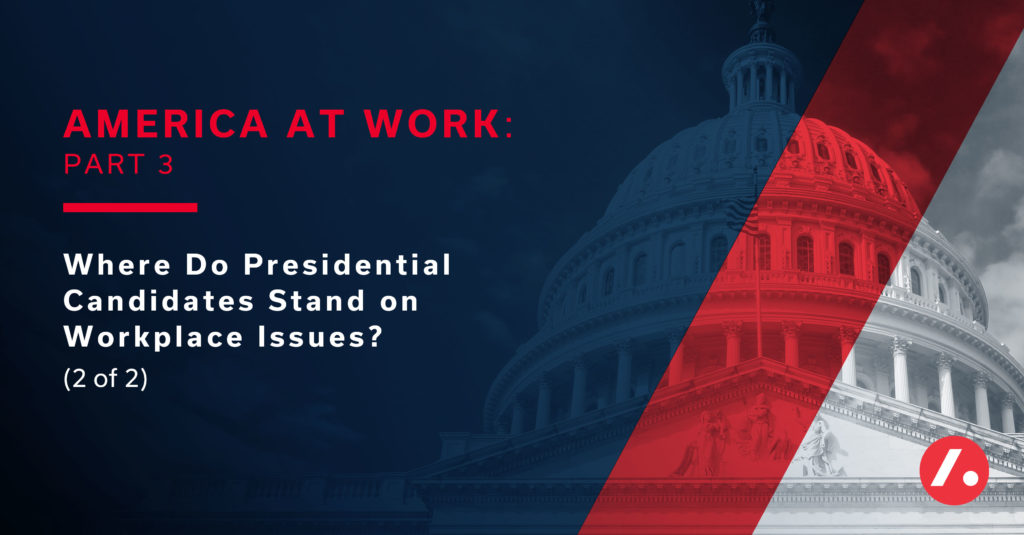
Where Do Presidential Candidates Stand on Workplace Issues? (2 of 2)
In our 4-part blog series, “America at Work,” we’re taking a look at workforce trends and perspectives across the United States.
In May, Money published this article about America’s 2020 presidential candidates, citing their various stances on certain workplace issues. We recapped the first batch of candidates for you last week, and now it’s time to round out the rest of the field. As it happens, there’s a boatload of candidates—so we boldfaced some of their differentiators for easy reading.
Who is running for president, and where does each candidate stand on workplace issues?
Amy Klobuchar (D)
From Minnesota, don’tyaknow? Looking for a higher minimum wage and lower gender wage gap. In favor of labor. Calling for companies to require a minimum retirement contribution for workers. All-in on paid sick, medical leave, and more employee training.
Wayne Messam (D)
Florida man! Business owner. Wants to re-establish the “American Dream” by way of better pay and protections for people. Dislikes corporate greed and tax cuts for big corporations. Cites stock buybacks as detriments to U.S. economy.
Seth Moulton (D)
New Englander. Believes giving Americans “more access to the workforce and the right jobs for them” will create jobs and improve the country’s infrastructure. Supports Green New Deal. Wants our tax system to support the middle class and small businesses.
Beto O’Rourke (D)
Smiley Texan. Supports Dem-centric minimum wage increase, LGBTQ rights in the workplace, and right for workers to unionize. Has co-sponsored Acts promoting equal pay for women and paid family leave. Wants to organize trade agreements with countries worldwide.
Tim Ryan (D)
Ohio congressman. Federal minimum wage raiser, wage gap closer, and paid leave purveyor. Wants aid for laid-off American workers and legislation to secure protection for pregnant workers. Pushing legislation for a “green economy.”
Bernie Sanders (D)
Political revolutionary from Vermont. Has long addressed economic inequality across the country. Going to war against major corporations, “pushing for better workplace conditions, higher pay, and the right to unionize.” Co-sponsor of FAMILY Act (12 weeks of paid family and medical leave).
Donald Trump (R)
The Donald. President of the United States. Owns steady job creation and record low unemployment numbers as Commander in Chief. At war against trade with foreign entities. Supports minimum wage status quo. No signs of covering discrimination in the workplace.
Elizabeth Warren (D)
Worker-friendly lawmaker. Introduced bill that will give workers a say in who sits on company boards and “redirect trillions of dollars to workers.” Wants to protect farmers, make childcare less expensive, and pay childcare workers more money. Proposes a wealth tax.
Bill Weld (R)
Sole Trump Challenger. Former Libertarian Vice Presidential candidate. Fiscal conservative despite liberal social views. Low on minimum wage hikes. Fiercely opposed to socialism. “The two most important tasks are to cut spending and to cut taxes—and spending comes first.”
Marianne Williamson (D)
Author and speaker. Thinks minimum wage pay should be based on geographic location. Pro union, paid and medical leave, and equal pay. Wants to give $1,000 a month to American adults aged 18 to 65 and a universal savings program (cash gift from government at birth).
Andrew Yang (D)
Entrepreneur. Supports “Freedom Dividend”: will give American adults $1,000 per month to make ends meet and find better jobs. Targeting help for Americans in the workplace: refunding options, salary disclosure laws, paid leave for full-time workers and contractors alike.
Which one of these presidential candidates will become a major contender in 2020? Time will tell. Until then, we’ll be keeping our eye on the needle—and so should you. Your place in the American workforce could be in play for a major shakeup.
For more news, notes, and tips from Acara Solutions, visit our resources page. And don’t forget to check us out on Twitter, LinkedIn, Facebook, and Instagram.




